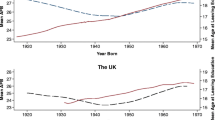Abstract.
Several studies have shown that at the individual level there exists a negative relationship between age at first birth and completed fertility. Using twin data in order to control for unobserved heterogeneity as possible source of bias, Kohler et al. (2001) showed the significant presence of such "postponement effect" at the micro level. In this paper, we apply sample selection models, where selection is based on having or not having had a first birth at all, to estimate the impact of postponing first births on subsequent fertility for four European nations, three of which have now lowest-low fertility levels. We use data from a set of comparative surveys (Fertility and Family Surveys), and we apply sample selection models on the logarithm of total fertility and on the progression to the second birth. Our results show that postponement effects are only very slightly affected by sample selection biases, so that sample selection models do not improve significantly the results of standard regression techniques on selected samples. Our results confirm that the postponement effect is higher in countries with lowest-low fertility levels.
Similar content being viewed by others
Author information
Authors and Affiliations
Corresponding author
Rights and permissions
About this article
Cite this article
Billari, F.C., Borgoni, R. Assessing the use of sample selection models in the estimation of fertility postponement effects. JISS 14, 389–402 (2005). https://doi.org/10.1007/s10260-005-0122-x
Issue Date:
DOI: https://doi.org/10.1007/s10260-005-0122-x




